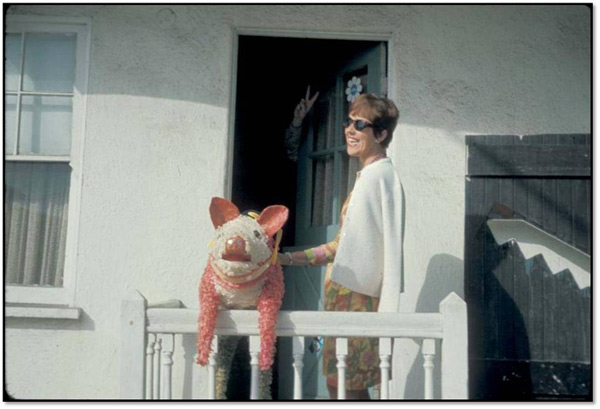As I wait, just a little anxiously, for publication of
the new Thomas Pynchon novel Bleeding
Edge, I’ve been rereading The Crying
Of Lot 49, Pynchon’s short, pithy, intermittently playful, second novel, the one that even Pynchon skeptics can just about manage
to get through.
Since Pynchon’s concerns are so broad it’s hardly surprising
that he has things to say about eating and drinking, but I hadn’t realized quite
what a smorgasbord of foodie reference Lot 49 actually is. Everybody remembers the
opening paragraph in which Oedipa Maas returns “from a Tupperware party whose
hostess had put perhaps too
much kirsch in the fondue, to find that she, had been named executor, or she
supposed executrix, of the estate of one Pierce Inverarity, a California real
estate mogul.” She ponders the
significance of this “through the sunned gathering
of her marjoram and
sweet basil from the herb garden herb, reading of book reviews in the latest Scientific
American, into the layering of
a lasagna, garlicking of a bread, tearing
up of romaine leaves, eventually, oven on, into the mixing of the twilight's whiskey sours against the arrival of her husband, Wendell
("Mucho") Maas.”
And then there’s the dandelion wine made by Mike Fallopian, who says, "I picked the dandelions in a cemetery, two years ago. Now the cemetery is gone. They took it out for the East San Narciso Freeway.” And then, "It's clearer now," he said, rather formal. "A few months ago it got quite cloudy. You see, in spring, when the dandelions begin to bloom again, the wine goes through a fermentation. As if they remembered."
And then there’s the dandelion wine made by Mike Fallopian, who says, "I picked the dandelions in a cemetery, two years ago. Now the cemetery is gone. They took it out for the East San Narciso Freeway.” And then, "It's clearer now," he said, rather formal. "A few months ago it got quite cloudy. You see, in spring, when the dandelions begin to bloom again, the wine goes through a fermentation. As if they remembered."
Phyllis Gebauer a
lifelong friend, who knew Pynchon back in his Seattle days writes in a
“mini-memoir,” "Tom at the time was working on The Crying of Lot 49,' and when that book came out and I read about
his heroine -- Oedipa Maas -- 'layering lasagna' at the beginning of Chapter
One, well, I can't prove it, but hey -- I'm sure that was our lasagna!"
Soon
on the road Oedipa (rather than Phyllis) meets the lawyer dealing with the
case, Metzger, who seduces her, by means of a bottle of illegally imported “French
Beaujolais,” then tequila, eschewing salt and lime, saying that’s just for
the tourists.
Oedipa attends a Yoyodyne stockholders' meeting, in a quonset building painted pink and about a hundred
yards long, actually the Yoyodyne Cafeteria.
“Around them all, Negroes carried gunboats of mashed potatoes, spinach,
shrimp, zucchini, pot roast, to the long, glittering steam tables, preparing to feed a noontide invasion of Yoyodyne workers.”
The novel also features a bar called The Scope, where
they hold jam sessions for electronic musicians, a rather more mind-blowing
concept then than now, a gay bar called The Greek Way, and at one point Oedipa
finds herself in a 24-hour Mexican greasy spoon in San Francisco, where she
runs into one of her old acquaintances, “idly stirring his bowl of opaque soup
with the foot of a chicken.”
But of course The
Crying Of Lot 49 isn’t a really a book about food and drink. It’s a book about communication systems and postal
cartels, whether run by governments, or by more or less sinister private organizations. There’s a good deal about the Thurn und Taxis
family, once imperial couriers to the Holy Roman Empire, with monopolies
throughout Europe.
When I first read the book I wasn’t sure how much, if
any, of the Thurn und Taxis stuff was “real.”
The name sounded as preposterous as any of Pynchon’s made up names. But it was indeed real, a fact I confirmed in
part by seeing pictures of Gloria Thurn und Taxis in various fashion magazines
and in this photograph by Helmut Newton, aboard her
yacht L’Aiglon.
What I didn’t know until
about two days ago was that for a long time the family was also in the beer business,
and still is at least nominally. The family's brewery was sold to the Paulaner Group in the 1990s, but
beer is still produced under the Thurn und Taxis name, as these photographs
show.
The lady there is once again, Gloria. And what exactly is she eating? It looks like a schwein hock to me. I’d never really have had her down as a
schwein hock eater, but good for her.
Thomas Pynchon I believe was fond of pigs (he named one of his major characters Pig Bodine), possibly of eating them too. Here is the front endpaper of the copy of Gravity’s Rainbow, that he signed and dedicated to Phyllis Gebauer and her husband. (Phyllis died in 2011, the photograph is by Carolyn Kellogg.)
Thomas Pynchon I believe was fond of pigs (he named one of his major characters Pig Bodine), possibly of eating them too. Here is the front endpaper of the copy of Gravity’s Rainbow, that he signed and dedicated to Phyllis Gebauer and her husband. (Phyllis died in 2011, the photograph is by Carolyn Kellogg.)
Word is, the connection between Pynchon, the Gebauers and pigs was established when they bought him a
pig-shaped piñata, though in what circumstances I’m not sure. And here, incredibly (incredible in the sense
that it’s just floating around the Internet, and has been for a couple of years) is a picture of Phyllis with that
very Pynchonian piñata. And that hand giving the peace sign from behind the door is apparently the man himself.












No comments:
Post a Comment